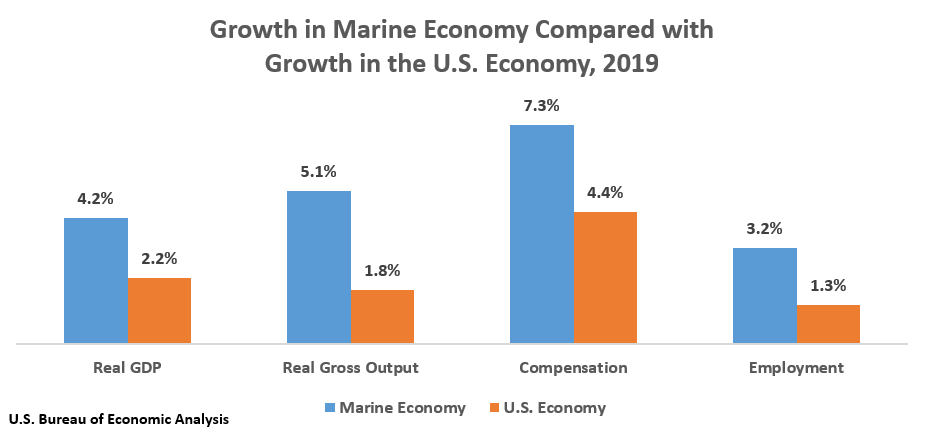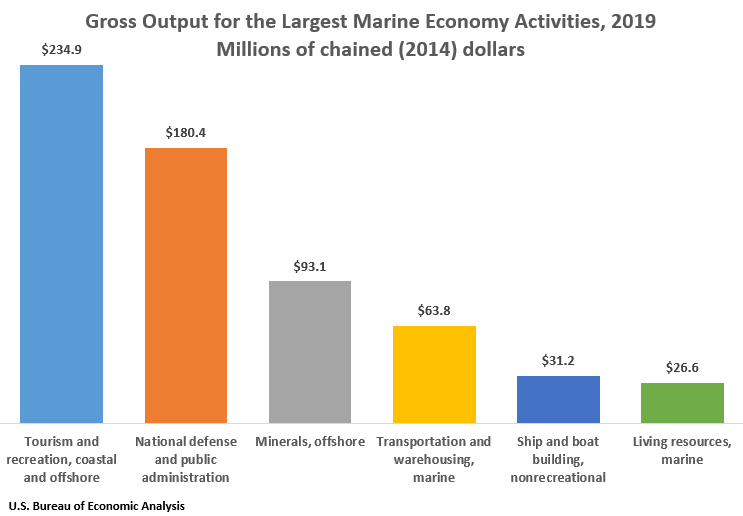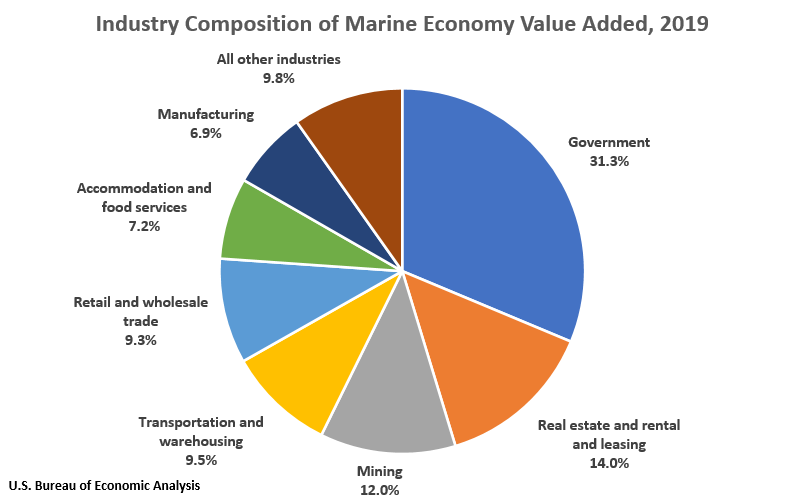News Release
Marine Economy Satellite Account, 2014-2019
Marine economy accounted for 1.9 percent of GDP in 2019
The first official Marine Economy Satellite Account statistics released today by the U.S. Bureau of Economic Analysis show that the marine economy accounted for 1.9 percent, or $397 billion, of current-dollar U.S. gross domestic product (GDP) in 2019 (table 11).
The new statistics show that inflation-adjusted (real) GDP for the marine economy grew 4.2 percent in 2019, faster than the 2.2 percent growth for the overall U.S. economy (table 14). Real gross output, compensation, and employment also all grew faster in the marine economy than in the overall economy in 2019.
This official release updates BEA’s prototype estimates of current-dollar gross output, value added, employment, and compensation for the marine economy from 2014-2018, released last year. It also introduces inflation-adjusted (real) estimates of gross output and value added (GDP) by both industry and activity for the marine economy.
The statistics released today are updated to include refinements in methodology and presentation incorporated by BEA after receiving public feedback to the prototype statistics released June 2, 2020. The Marine Economy Satellite Account is the latest addition in a series of satellite accounts complementing BEA’s statistics. These satellite accounts do not change BEA’s core statistics, such as GDP. They provide greater detail and allow closer analysis of a specific area of the economy by extracting information embedded in the core economic statistics.
Marine Economy by Activity
In the Marine Economy Satellite Account, gross output—principally a measure of sales or receipts associated with the marine economy—is presented both by industry and by marine economy activity. Marine economy activities fall into ten general categories. In 2019, tourism and recreation (including activities such as coastal trips and travel, offshore boating, and offshore recreational fishing) accounted for 35.3 percent of marine economy gross output; national defense and public administration accounted for 27.1 percent; and minerals, offshore (including offshore oil and gas), accounted for 14.0 percent (table 20).
- Tourism and recreation was the largest marine economy activity in 2019, accounting for $234.9 billion of gross output.
- Nonrecreational ship and boat building accounted for $31.2 billion of gross output in 2019. This activity increased $8.5 billion (37.2 percent) from the previous year, making it one of the fastest-growing marine economy activities.
- Marine transportation and warehousing accounted for $63.8 billion, or 9.6 percent, of gross output in 2019.
Marine Economy by Industry
Marine economy value added is presented by industry, which shows how an industry’s participation in the marine economy contributes to GDP. For example, the data show that the government sector was the largest contributor to the marine economy in 2019, accounting for 31.3 percent ($124.3 billion) of all marine economy activity (table 10). Government was also the largest industry sector for compensation ($76.0 billion) and for employment (647,000).
- Real estate and rental and leasing had the second largest contribution to the marine economy, accounting for $55.5 billion of value added.
- Transportation and warehousing was the second-largest industry for compensation ($21.3 billion), with 43.3 percent of this value coming from the category “other transportation and support activities” which includes scenic and sightseeing transportation.
- Accommodation and food services was the second-largest industry for employment (464,000) in 2019.
The Marine Economy Satellite Account (MESA) measures the economic activity associated with the marine economy, identifies the industries responsible for producing these goods and services, and measures the output, value added, compensation, and employment associated with that production. Like other satellite accounts, the MESA was built on BEA’s comprehensive supply-use framework. The supply-use tables provide a detailed look at the relationships among industries and how each industry contributes to gross domestic product (GDP). In practice, the MESA is a rearrangement of the published supply-use tables that isolates marine-related spending and production. A variety of private and public data sources were used to identify marine-related spending and production in order to develop the MESA estimates.
An important feature of the MESA is the presentation of estimates of gross output and value added by marine economic activity, in addition to the traditional presentation of estimates by industry. This allows for the marine economy to be better analyzed in areas where significant economic activity occurs across a variety of traditional industries. For example, the marine tourism and recreation activity spans a variety of traditional industries which can create difficulties when attempting to analyze the magnitude and growth of marine tourism and recreation. By presenting the statistics by activity, the MESA allows for a more focused examination of marine economic activity in the United States.
The geographic scope of the MESA includes the Atlantic, Pacific, and Arctic Oceans within the Exclusive Economic Zone (approximately 200 nautical miles off the U.S. coast) as well as marginal seas such as the Gulf of Mexico, Chesapeake Bay, Puget Sound, Long Island Sound, San Francisco Bay, and others. Also included is the U.S. shoreline directly along these bodies of water. Furthermore, the Great Lakes are included up to the international boundary with Canada.
Additional information on the marine economy statistics and the data sources and methodology that underlie their preparation are available here: www.bea.gov/system/files/2021-06/defining-and-measuring-the-united-states-ocean-economy.pdf.
The Marine Economy Satellite Account was produced in partnership with the National Oceanic and Atmospheric Administration (NOAA).


